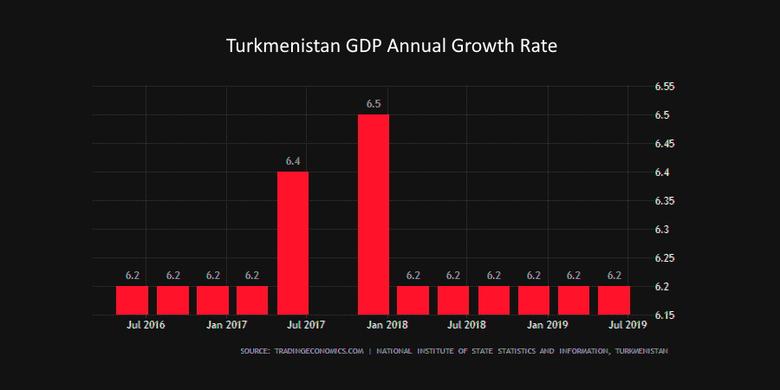
TURKMENISTAN GDP GROWTH 6.3%

IMF - November 14, 2019 - IMF Staff Concludes Staff Visit to Turkmenistan
- Turkmenistan continues to pursue an investment-led growth strategy underpinned by import substitution and export promotion policies, directed concessional lending, and related broad exchange controls on international transactions and payments.
- Developing the private sector and diversifying the economy away from hydrocarbon exports requires stepping up reforms to ease administrative control, opening the economy to competition, and improving transparency.
- Increasing healthcare and education spending and targeting it better toward achieving human development outcomes is essential for nurturing talent and creating opportunities for all citizens.
An International Monetary Fund (IMF) mission led by Ms. Natalia Tamirisa visited Ashgabat during November 5-12, 2019 to assess recent developments and discuss economic and financial policy priorities with senior government officials, representatives of the business and financial sectors, and the diplomatic community.
At the end of the visit, Ms. Tamirisa issued the following statement:
“Economic growth continues to be driven by both the hydrocarbon and nonhydrocarbon sectors. External balances remain in surplus, buoyed by exchange controls in line with import substitution and export promotion objectives. Under current policies, economic growth is expected to moderate over the medium term as hydrocarbon production stabilizes. Risks are tilted to the downside and include lower-than-expected hydrocarbon prices and returns on past investment, rising external financing costs, and geopolitical factors.
“Significant overvaluation and foreign currency rationing are among the factors that weigh on private investment and competitiveness of nonhydrocarbon exports. Achieving sustainable economic growth requires improving the competitiveness and convertibility of the manat. Adjustment should be carefully sequenced to ensure macro-financial stability and supported by measures to protect the vulnerable.
“Reducing the footprint of the state and opening the economy to competition are important to promote economic efficiency and market development. Alongside, phasing out directed cheap credit would help steer financial resources to the most productive use and would help create a market-based, more efficient financial system. Prudential oversight should be strengthened in tandem to maintain financial stability.
“Steps to improve the efficiency of public spending are needed to increase its impact while saving public financial resources. Higher, and better targeted, spending on health and education is crucial to foster human development and improve inclusiveness. Stronger economic policy frameworks and transparency would help ensure sound decision-making and improve access to financing.
“The IMF team is grateful to the authorities and other stakeholders for their warm hospitality and insightful discussions. The team stands ready to support the authorities in their efforts to strengthen capacity, including in public finance and debt management, monetary and exchange rate operations, and national accounts, price and external statistics. The next Article IV Consultation mission is scheduled for March 2020.”
|
Turkmenistan: Selected Economic and Financial Indicators, 2015–19 |
||||||||||||||||||||||||||||||||||||||||||||||||||||||||||||||||||||||||||||||||||||||||||||||||||||||||||||||||||||||||||||||||||||||||||||||||||||||||||||||||||||||||||||||||||||||||||||||||||||||||||||||||||
|
||||||||||||||||||||||||||||||||||||||||||||||||||||||||||||||||||||||||||||||||||||||||||||||||||||||||||||||||||||||||||||||||||||||||||||||||||||||||||||||||||||||||||||||||||||||||||||||||||||||||||||||||||
-----
Earlier:

2019, August, 13, 13:20:00
1ST CASPIAN ECONOMIC FORUM
Five countries bordering the energy-rich Caspian Sea met Monday at an economic forum hosted by Turkmenistan in a bid to agree on how to divide the region's oil wealth.
|

2019, July, 4, 16:00:00
TURKMEN GAS FOR GAZPROM
the Gazprom Group signed a five-year contract to purchase natural gas from Turkmengas (for the period through June 30, 2024).
|

2018, August, 10, 10:40:00
TAPI PIPELINE FOR CHINA
REUTERS - Originating at the giant Galkynysh gas field in Turkmenistan, the $9.6 billion TAPI (Turkmenistan, Afghanistan, Pakistan and India) pipeline involves the four countries’ own energy companies, and would carry 33 billion cubic metres (bcm) of gas a year.
|












